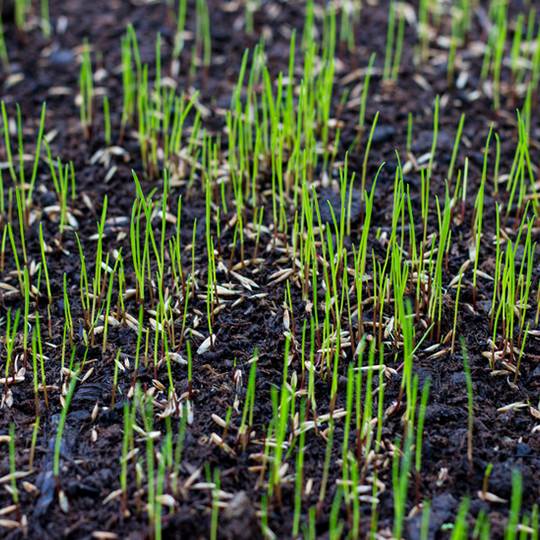Overseeding Your Lawn
Why, When, and How it’s Done
Posted
April 2, 2020

Now is the time grass should be waking from its long winter nap and showing greener signs of life. Take a look at your lawn. Does it look any different? If it’s still not looking its best by fall, it may be time for overseeding your lawn.
What is Overseeding
Does your lawn look worn out? Does it seem to always need water or fertilizer? Are you constantly fighting against insects? Then your grass could use some revitalization in the form of overseeding—or planting new seed directly over existing turf.
There’s no need to dig up any soil. You simply want to fill in bare spots, improve grass density, and enhance your lawn’s color. Newer turf varieties are also less susceptible to insects, disease, drought, and heavy traffic.
Before you decide to overseed, it’s best to learn why your grass looks the way it does. Overseeding can’t help correct all grass issues, including:
- Poor soil condition and air circulation
- Improper drainage
- Soil compaction and thatch
- Insufficient sunlight
- The wrong type of grass for the area
- Neglect
If any of these problems exist, new grass is also likely to suffer. If you have trouble identifying the problem, contact Cardinal Lawns for help. You want to correct the problem before you establish new grass.
What Type of Grass is Best
In order for overseeding to be successful, you should spread the type of seed that will thrive in the climate. Cool-season grasses—such as Kentucky Bluegrass, Ryegrass, and Bentgrass—grow well in western, northern and eastern areas of the United States. Warm-season grasses—Bermudagrass, Centipedegrass, and Bahiagrass—survive the extreme heat of the south, southeast, and southwest, but do not like freezing temperatures.
Best Time for Overseeding Your Lawn
As with all lawn maintenance, this depends on the type of grass you have and the climate in which you live. Typically late summer or early fall is the best time to overseed lawns. During this time, the soil and air temperature are better for optimal germination. There’s also less competition with weeds at this time.
What’s wrong with the other seasons?
- Spring. Heavy rains, extreme changes in temperature, and weeds make this a bad time to try and spread new seeds.
- Summer. Extreme heat and drought make it difficult for seeds to establish.
- Winter. Seeding during the dormant season only works if there will be a decent amount of snow cover to help prevent wind and water erosion.
How to Overseed Your Lawn
Before you start, break up any layer of thatch more than a half-inch thick. There’s no use seeding over thatch since it’s unlikely the seeds will make it to the soil to properly germinate. Even if they do, new grass will have a difficult time growing through the thatch.
There are several methods that help make overseeding a lot easier.
Broadcast seed. It’s best to aerate your lawn and remove the soil plugs before using this method. Opening up the soil makes it easier for the seeds to make enough contact for proper germination. Use a cyclone or drop-type seeder to evenly spread the seed.
Slit-seeder. Blades cut through the soil, creating a slit for the grass seed to drop in for germination. This is a more efficient way to overseed as it uses fewer seeds than broadcast seeding since they’re deposited directly into the slits.
What Comes After Overseeding
Once the seeds are down, proper watering is important to the entire process.
- Directly after overseeding, water heavily to wash grass seeds into slits or aerated holes.
- For the next two weeks, until germination, water daily by soaking about an inch of soil.
- After germination, water less frequently. When you do water, deeply soak the soil. This encourages deep root growth.
- After the grass is established, follow the recommended watering guidelines for the type of grass you’ve planted.
With proper overseeding, the overall look and health of your lawn improves, making it easier to mow and maintain.
Special Offer for New Customers
Two Free Lawn Care Treatments
Hurry! Offer Expires April 30, 2025